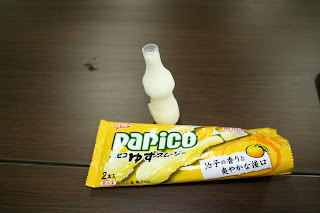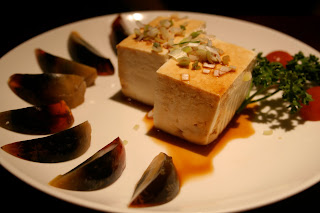I made it up this morning in good time to make it down to Sapporo Station. We met in front of Mister Donut (who still has nothing on Tim Horton’s), received our tickets to Hakodate, and boarded the train. I am glad we had people who knew where they were going around, because I don’t know if I could have found the gate myself. We boarded the train about 4 minutes before it departed.
Given the lack of sleep, I spent a good portion of the train ride catching what little sleep I could capture between stops. This is the train that April and I will be catching when we go to Noboribetsu and later when we head to Tokyo, so in that sense I was doing a little advance work for next week.
The countryside reminds me of the Fraser Valley. With mountains never far in the distance, the Japanese have had to learn how to do agriculture intensively on small areas of arable land.
On the train we had a bento box with rice topped with shredded crab—it was really delicious. I filled up two water bottles before I left so I didn’t have to shell out 150-200 Yen for water or a pop. Good planning, and it’s good water here.
Hakodate is a touristly little town. It was one of the three ports that were opened to trade with the outside world in the 19th century—the other two being Nagasaki and Yokohama. Why Hakodate never turned into the larger centres like the other two is probably because it was still the frontier of the Japanese empire at the time. Hokkaido is relatively recently colonized by the Japanese (19th and 20th century), and before that there it was very sparsely populated (and still is relative to the rest of Japan).
The city’s claim to fame is that it is where Commodore Perry landed and there are plenty of murals depicting that. We toured a Chinese cultural centre from the last century, an old mansion, had tea at the former British Consulate (a professor from London commented that he travelled half way across the world only to have tea at the British Consulate) and a saw really cool Ainu museum. The Ainu are the indigenous people of Hokkaido and the northern islands and are very much related to the Aleuts in Alaska, and, I highly suspect, the aboriginals along the coast of British Columbia.
We had dinner as a group and to my surprise the main organizers asked me if I could do a closing toast. I obliged and made a small speech about friends, thanked the organizers for putting on an amazing show, and importantly thanking professor Iwashita for his role at the Slavic Research Centre as tonight was his last night as its director (he is still being the director of the Center of Excellence, I understand). I had some compliments on the toast, but I still think it’s funny that the organizer chose me. It’s very flattering.
 |
| We'll do this stop next week |
 |
| Feels just like the Fraser Valley here |
 |
| The standard slippers are generally too small for my feet. I did manage to obtain some larger ones on this tour. |
 |
| Shrine at the Chinese cultural centre. Amazing |
 |
| A fiesty little fox at a shrine we walked around. I liked the look of him... growly but impish all in one. |




























